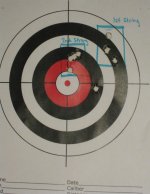If your MAAS is the same stuff in a tube as the Flitz-like MAAS I have, you would have to work at if for what would seem like an eternity to remove two or three thousandths. Even hand lapping a bore with 320 grit silicone carbide compound takes a long time to remove a quarter thousandth. If you are finding a two to three thousandths fit difference with a telescoping gauge or by measuring the fired case OD change, I would guess it is most likely wire edges being removed from the scoring in the chamber?
Measuring a fired case will come close to telling you what you've got? For a chamber to remain within SAAMI spec. Figure it will have sprung back about half a thousandth. If I allow for that haf thousandth, the diameter at the widest part of the shoulder should not exceed 0.4566". 1.25" up from the bottom (case sitting mouth-up on a flat surface) it should not exceed 0.4579" diameter. 0.2" up from the bottom it should not exceed 0.4729". Use a headspace gauge to determine that headspace length is within spec (1.6380" max field No-go rejection, commercial, and 1.6445" max field rejection for 7.62 x 51 NATO).
Second, I have to respectfully disagree with the prior emphasis on avoiding over-polishing. Varmint Al has some excellent FEA work in his page on
chamber finish friction effects. Contrary to popular belief, though polishing to Flitz mirror finish levels drops the coefficient of friction in half (and this would be for a smooth, score-free surface), this only increased bolt face thrust in his .243 Win from about 4000 pounds with a rough chamber to about 4800 lbs with the dead smooth one. Most well-gunsmithed chambers are somewhere inbetween, so this would probably constitute about a 10% increase over an average chamber which would have around 4400 pounds thrust. But because the cases could slip rearward a little more easily, almost all case stretching and thinning at the pressure ring stopped, greatly reducing the chances of a head separation, and greatly increasing reloading life of the brass if you keep the necks annealed.
What causes a neck to stretch begins when the stretched case from the chamber is forced into a sizing die. As it enters the die, the sides make contact with the die before the shoulder, which squeezes the case narrower, making it still longer. Then, when the shoulder makes contact with the shoulder part of the die and is pushed back, you now have brass from the extra length that has to go somewhere? A little will flow rearward, but not very much. Enough to shorten a case half a thousandth to a thousandth. Most of the extra brass flows up from the shoulder and into the neck. This brass flow forms the internal "dreaded donut" and lengthens the neck. I have an exaggerated illustration of it happening that I'll tag onto the end of this post.
Your chamber's original condition resulted from the gunsmith starting with a barrel that had an oversize roughed chamber, then used a finishing reamer without adequately frequent stops for chip cleaning and re-lubing. I got two L.E. Wilson standard contour Garand barrels that came with oversize roughed chambers like that. I used a pull-through reamer on them, and the reamer only touched them from about half-way forward. I was careful to stop and remove the reamer and clear chips from the chamber and the reamer and to add fresh cutting oil every couple or three turns. I discovered the hard way that bad scoring results if you don't.
If your gunsmith used a pull-through reamer (you can make the same mess with a standard reamer) a plus would be that the chamber likely started at near minimum headspace. That would give you room to play with lapping. If you use fired cases to lap, the best way is to drill out and thread the flash hole and use removable Loctite so you can attach a rod to it so you have a handle with which you can lap with a back-and-forth motion by rubbing the rod between your palms. This is the motion used to lap engine valves. Rotating in one direction usually results in visible circumferential surface scuffing or scoring. The back and forth will let you create a truly smooth surface. Rotating the case about two fifths of a third every few back-and-forth motions will even out case shape errors, keeping the chamber round.
Some cases that have been put through full-auto guns just never recover shape completely. A board member sent me some once-fired cases he could not make work in his .223. He had sized them, sized them again in small base dies, bought another brand of die and tried again, and basically did all one could reasonably expect. I measured them and found the headspace datum were everywhere from -0.008" to +0.015" relative to a good quality .223 GO gauge. The shorties were still too fat to chamber. So, there are some cases that just start too darn big to be reused usefully. Most of these will be thin in the pressure ring, anyway, so I would just toss anything a small base die can't bring down far enough on the first pass. There will be some.


